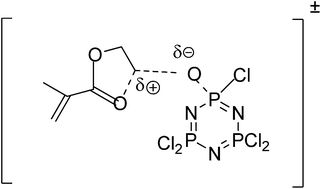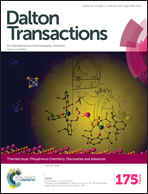The mechanism of a phosphazene–phosphazane rearrangement†
Abstract
The phosphazene–phosphazane rearrangement of N3P3Cl5O(CH2)2OC(![[double bond, length as m-dash]](https://www.rsc.org/images/entities/char_e001.gif) O)CMe
O)CMe![[double bond, length as m-dash]](https://www.rsc.org/images/entities/char_e001.gif) CH2 (8) has been examined in detail using one and two dimensional NMR (31P, 1H) spectroscopy and mass spectrometry. The mixed phosphazene–phosphazane [NPCl2]2[N((CH2)2OC(
CH2 (8) has been examined in detail using one and two dimensional NMR (31P, 1H) spectroscopy and mass spectrometry. The mixed phosphazene–phosphazane [NPCl2]2[N((CH2)2OC(![[double bond, length as m-dash]](https://www.rsc.org/images/entities/char_e001.gif) O)CMe
O)CMe![[double bond, length as m-dash]](https://www.rsc.org/images/entities/char_e001.gif) CH2)P(O)Cl] (14), [NPCl2]2[NHP(O)Cl] (13) and a two ring assembly [NPCl2]2[NP(O{(NPCl2)2(N((CH2)2OC(
CH2)P(O)Cl] (14), [NPCl2]2[NHP(O)Cl] (13) and a two ring assembly [NPCl2]2[NP(O{(NPCl2)2(N((CH2)2OC(![[double bond, length as m-dash]](https://www.rsc.org/images/entities/char_e001.gif) O)CMe
O)CMe![[double bond, length as m-dash]](https://www.rsc.org/images/entities/char_e001.gif) CH2)P(O)}] (15) have all been detected in the product mixture. The rate of the rearrangement has been measured at five temperatures by 31P and 1H NMR. The reaction is first order in 8 (T1/2 at 111° is 4.65 hours). The activation enthalpy is positive and the activation entropy is negative. A mechanism involving competing intra and inter molecular processes which fits the product distribution and kinetic data has been proposed. Several other methyacrylphosphazenes were examined under the same thermolysis conditions. The rearrangement was observed and the rates obtained in cases where the (CH2)2 spacer unit of the methacrylate was replaced by linear and branched propyl units. The rearrangement was not observed when the methacrylate was appended to a spirocyclic unit, the spacer unit was extended to the n-butyl group and when the methacrylate unit was replaced by a methoxy group. These results are all consistent with the proposed mechanism. This investigation resolves conflicting results previous reported for the rearrangement.
CH2)P(O)}] (15) have all been detected in the product mixture. The rate of the rearrangement has been measured at five temperatures by 31P and 1H NMR. The reaction is first order in 8 (T1/2 at 111° is 4.65 hours). The activation enthalpy is positive and the activation entropy is negative. A mechanism involving competing intra and inter molecular processes which fits the product distribution and kinetic data has been proposed. Several other methyacrylphosphazenes were examined under the same thermolysis conditions. The rearrangement was observed and the rates obtained in cases where the (CH2)2 spacer unit of the methacrylate was replaced by linear and branched propyl units. The rearrangement was not observed when the methacrylate was appended to a spirocyclic unit, the spacer unit was extended to the n-butyl group and when the methacrylate unit was replaced by a methoxy group. These results are all consistent with the proposed mechanism. This investigation resolves conflicting results previous reported for the rearrangement.

- This article is part of the themed collection: Phosphorus Chemistry: Discoveries and Advances

 Please wait while we load your content...
Please wait while we load your content...